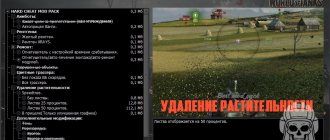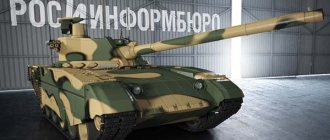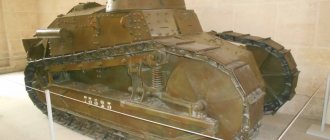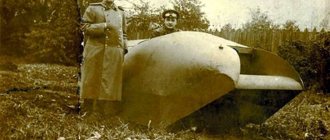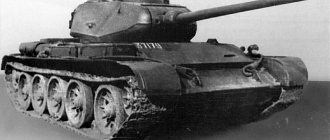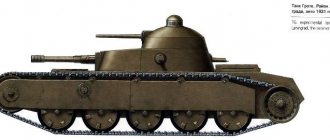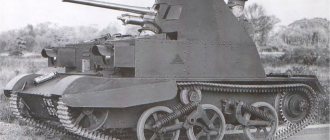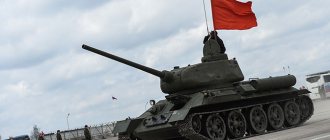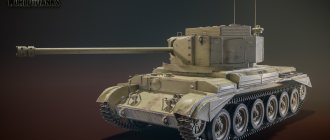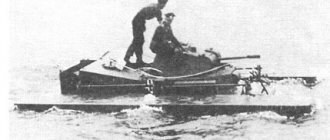Literature and sources of information
Katorin Y. Cruisers. Part 1 ISBN 978-5-8172-0126-0;978-5-81720-134-5 Shavykin N. Fleet Partisans. From the history of cruising and cruisers (Naval Chronicle) ISBN: 978-5-9533-5803-3 Nenakhov Yu. Encyclopedia of cruisers 1860—1910 ISBN: 5-17-030194-4 Jane's Fighting Ships 1919 Brassey's Naval Annual 1912
Links
https://en.wikipedia.org/wiki/Challenger-class_cruiserhttps://military.wikia.com/wiki/Challenger-class_cruiserhttps://www.worldwar1.co.uk/light-cruiser/hms-Challenger.htmlhttps: //www.dreadnoughtproject.org/tfs/index.php/Challenger_Class_Cruiser_(1902)https://www.historyofwar.org/articles/weapons_challenger_class_cruisers.htmlhttps://www.korabli.eu/blogs/kreysera/velikobritaniya/bronepalubnye/ challengerhttps://www.navypedia.org/ships/uk/brit_cr_challenger.htmhttps://navalhistory.flixco.info/H/101948×53056/8330/a0.htm
Design
Armament
The Challenger 2 is equipped with a 120 mm L30A1 rifled gun, a successor to the guns found on the Chieftain and Challenger 1 tanks. This electroslag cast gun is the only rifled gun of this caliber used by NATO. The gun channel is chrome-plated, the gun is covered with a thermal insulating casing. The gun is stabilized in two planes, its guidance drives are completely electric. The main gun's ammunition capacity is 52 rounds.
To the left of the main gun is a coaxial 7.62 mm L94A1 machine gun. Near the commander's hatch on the turret there is a 7.62 mm L37A2 machine gun, which serves mainly for air defense. In total, the tank contains 4000 rounds of caliber 7.62
The digital fire control system, developed by , includes a 32-bit processor and a Mil Std 1553 data bus, the first installed on a British armored vehicle
Armor protection
The Challenger 2 is one of the most heavily armored Western tanks: both the turret and its hull are covered with second-generation Chobham armor, all information about which is still classified. Reactive armor packages were also used to armor the tank. The complex for protection against biological and chemical weapons is located inside the tower. In front, on both sides of the turret, there are five rechargeable launchers that fire smoke grenades. Challenger 2 can also create a smoke screen around itself by injecting diesel fuel into the exhaust ports. The tank has a huge weakened zone in the frontal projection, this is the NLD (Lower Frontal Detail) of the tank which does not have combined armor, i.e. it is a sheet of ordinary steel approximately 80-100mm thick. (comment by an English tanker after the incident with the penetration of the NLD, which was protected by remote sensing
Weakened zone in frontal projection
Characteristics of the Challenger 2 main battle tank
A country:Great BritainType:Main tankDate of issue:1988Length:11.57 mWidth:3.52 mHeight:2.49 mArmor, forehead:combined, equivalent to 800-1200 mm steel (presumably)Armor, side:combinedArmor, tower:combinedCrew:4 peopleEngine:Diesel Perkins CV 12TSA Condor, 1200 hp.Travel range:400 kmMaximum speed:56 km/hWeight:62.5 tonsWeapons:1x 120 mm L30A1 cannon (52 rounds), 1x 7.62 mm ATK Gun Systems Company L94A1 coaxial machine gun, 1x 7.62 mm L37A2 anti-aircraft machine gun (4000 7.62 mm rounds), 10x 66 mm launchers smoke grenades.
Combat use[edit]
Challenger 2 tanks were used in peacekeeping missions even before their first combat use during the invasion of Iraq in March 2003. At that time, the 7th Armored Brigade, part of the 1st Armored Division, was armed with 120 Challenger 2 tanks. Tanks were actively used during the Battle of Basra, where they provided fire support to British forces.
During the Iraq War, two incidents were recorded in which Challenger 2 tanks were hit:
- One tank was completely destroyed by “friendly fire” when one tank mistakenly hit another, killing two crew members and causing the destruction by high-explosive armor-piercing (HESH) ammunition in the rear and commander's hatch.
- In 2007, a shot from a hand-held anti-tank grenade launcher pierced the lower frontal part of the Challenger's hull, three of the driver's toes were torn off, and two other members of the tank's crew were also injured.
A case was recorded when, during battles, one of the Challengers received 15 hits from anti-tank grenade launchers without breaking through the armor. During the assault on Basra, about 70 RPG hits were recorded on Challenger tanks without penetrating the armor.
On March 26, 2003, Challengers took part in a tank battle when a column of Iraqi tanks attempted to attack British positions. During the battle, 15 Iraqi T-55s were destroyed, the British suffered no losses.
The tank's maneuverability turned out to be remarkable. Problems that were discovered during the Saif Saria 2 desert exercises that took place 18 months before the war were solved by stockpiling dust filters to increase the frequency of their replacement in tanks. An opinion was expressed as a result of practice about the poor suitability of the tank for battles in the desert.
The Russian press made allegations about the ineffectiveness of the suspension of this tank in not very severe frosts.
Modifications of the Challenger 2 tank
Challehger 2 Control - Command tank for the brigade commander.
Challehger 2 Command - Command tank for the squadron commander.
Challehger 2 export, for Oman . It features a cooling system designed for operation in hot climates, the 7.62 mm machine gun from the loader's hatch was replaced with a 12.7 mm M2NV machine gun, the tank received different tracks, air conditioning and a GPS system.
Challehger 2 (for the 2003 invasion of Iraq) 116 Challehger 2 tanks and 28 Challehger ARRV ARVs received new side screens and improved air filters. In addition, all tanks participating in the operation received identification systems: thermal panels and chevrons.
British main tank "Challenger 2"
Challehger 2E , export modification. Instead of the Condor engine, a German MTU 883 V-12 engine with a power of 1500 hp was installed, and instead of a TN54 transmission, a Renk HSWL 295TM automatic transmission was installed, the capacity of the fuel tanks was increased, and the range was also increased to 550 km. The commander and gunner received the latest generation French SAGEM sights and a modern combat information and control system. The coaxial machine gun was replaced by the German MG ZA1, and provision was made for installing a 12.7 mm machine gun on the loader's hatch. It was not exported, but is considered the main option for modernizing the British Challenger 2 tanks.
Driver Training Tank - DTT. Training tank for training driver mechanics on the Challenger 2 chassis. Similar in design to the earlier Challenger Training Tank, on the Challenger 1 chassis.
Engineer Tank System is a family of engineering vehicles based on the Challenger 2 tank, created to replace similar vehicles based on the earlier Chieftain tank. The family includes Trojan Titan bridgelayers . The UK ordered 33 of both. Both vehicles are well armored and have good mine protection. Interestingly, they are not conversions of the base tanks, but are re-designed on the same chassis. The Troyan engineer tank has a crew of three (all in the front compartment), and a remote-controlled 7.62 mm machine gun is located next to the commander's hatch. On the upper frontal plate of the hull there are two blocks of 5 smoke grenade launchers. In front of the machine, on the right, there is a hydraulic boom-manipulator, in the rear of the machine there is a platform for transporting fascines. There is also a track-laying bulldozer blade. You can control all the elements without leaving the car, watching the process using 9 television cameras. The combat weight of the Troyan engineer tank is 57.5 tons, the maximum speed is 56 km/h. The Titan bridge layer is designed for transporting and laying two bridges on an obstacle, with a length of 26 and 13.5 m. The bridge layer is made according to the “scissors” scheme and in this respect copies the machines based on the Chieftain. The combat weight of the Titan bridge layer is 71.6 tons, the crew is 3 people.
"Challenger 2" and the American "Abrams" from some angles are twin brothers. And the point here is clearly not a single computing system
STORY
The history of the Challenger brand began back in 1890, when two American inventors Benjamin Holt and Daniel Best decided to experiment with the use of steam-powered machines in agriculture. Daniel Best began his experiment by using a steam engine for the first time in the world on tractors. The first tractors, which appeared in 1889, turned out to be very bulky and heavy, constantly bogging down in soft soil. It was necessary to somehow solve the problem. The second inventor, Benjamin Holt, proposed increasing the contact area of the tractor with the ground and suggested replacing the wheels with tracks. The already modernized tractor was tested in 1904, and some time later Holt registered the Caterpillar brand, produced in his own production by the Holt Manufacturing Company. He didn’t think long about the name of the brand, which later became legendary: caterpillar is a caterpillar in English.
A real breakthrough occurred in the company in 1909, when tracked tractors began to be equipped with gasoline engines instead of steam engines. This is what made the brand famous. Almost at the same time, in 1910, Daniel Best's son, Clarence Leo Best, created his own company and began producing wheeled tractors with gasoline engines. 12 years later, in 1925, Holt Manufacturing Company and CL Best Tractor Company decided to join forces and created a new company, Caterpillar Tractor Company. Production was constantly evolving, inventors were reaching new and new heights. In 1987, a truly revolutionary breakthrough occurred - the newest high-speed crawler tractor was invented, which received the name Caterpillar Challenger. At the same time, the Challenger brand appeared, which is destined to become a legend in the tractor industry.
Since then, the range of equipment produced under the Challenger brand has expanded significantly and included wheeled tractors, combine harvesters, forage equipment, self-propelled sprayers and fertilizer spreaders, tillage units and mounted implements. Each piece of equipment has its own long history of success. The Challenger brand brings together the best models of agricultural machinery that can satisfy the needs of both small farms and large agro-industrial holdings.
With a rich history and decades of experience, the Challenger brand continues to expand. Today it brings together a complete range of modern and high-performance agricultural equipment. Many Challenger models are equipped with fully integrated Autoguide automatic steering systems, telemetry, and the GTA farm management system, which allows you to organize the work of agricultural enterprises even more efficiently. Challenger's goal is to partner with farmers and agricultural producers around the world to help them increase the efficiency, productivity and profitability of their businesses. Each machine in the Challenger track tractor range offers the best traction and performance in its class. The use of the patented Mobil Trac crawler system and rubber-reinforced tracks provides high productivity and low soil pressure, ensuring respect for the soil by significantly reducing soil compaction. Thanks to their large contact patch, tracked tractors provide less slippage, allow you to get more out of the fields and reduce costs compared to wheeled tractors of similar power.
The performance of Challenger tracked tractors has been phenomenal, with many customers finding that one tractor can replace multiple wheeled machines while maintaining—or even increasing—overall plant productivity. And Challenger is not going to stop there.
Description of design
The Challenger 2 MBT is designed according to the classic layout. In the bow of the vehicle there is a control compartment, followed by the fighting compartment and the engine and transmission compartment located in the rear of the tank.
Crew arrangement in the Challenger 2 tank
The turret and hull of the tank are made of second-generation Chobham multi-layer armor. It is possible to install (optional) ROMOR dynamic protection modules and lattice screens on the sides of the machine body. The only “weak” area of the tank is the lower frontal part, which, in fact, is an ordinary sheet of armor steel, but it can be strengthened with dynamic protection. Taking into account dynamic protection and lattice screens, the total weight of the Challenger-2 is 74.95 tons. It is believed that the overall level of protection of the tank from BPS and KS is not inferior to the German Leopard-2 modification A5.
Challenger 2 is armed with a rifled 120-mm L30A1 cannon, the bore of which is chrome-plated. The ammunition load is 52 rounds of separate loading, and the charges and shells are stored separately from each other. The ammunition load includes high-explosive fragmentation, armor-piercing sub-caliber and smoke shells.
Structure diagram
The gun guidance drives are electric. The outside of the barrel is covered with a special casing; the L30A1 gun is stabilized in two planes.
The L94A1 machine gun (7.62 mm) is paired with the gun; another remote-controlled L37A2 machine gun (7.62 mm) is located on the roof of the turret.
The tank has a fire control system developed by . The basic modification of the vehicle had one thermal imager, which provided an image to both the commander and the gunner. Since 2007, each of them received their own device. A well-trained crew on a Challenger 2 tank can hit seven targets in one minute.
Highway speed 60 km
The vehicle's control system includes a General Dynamics Canada ballistic computer, a stabilized commander's day sight VS 580 (360° viewing angle, the same installed on the French Leclerc), as well as the main (also stabilized) gunner's sight with a laser rangefinder and a thermal imager.
Challenger 2 has hydropneumatic suspension. The tank is equipped with a Perkins 12V engine with a power of 1200 hp. With. and a hydromechanical transmission TN-54, which provides 6 forward and 2 reverse gears.
MBT "Challenger-1/2/2E"Challenger 1 is a modification of the Shir 2 tank, originally produced for Iran. The first examples were delivered by Royal Ordnance Leeds (the company was acquired by Vickers Defense Systems in 1986) by March 1983, and production continued until 1990, by which time 420 vehicles had been produced. Further developments led to the creation of the Challenger 2 tank. Challenger 1 tanks are equipped with a Barr & Stroud thermal imaging surveillance and targeting system.
MBT "Challenger 1"
Challenger 1 can be equipped with a self-excavation device or a demining device. Challenger 1s, which were used in the Middle East, were equipped with additional armor protection. In June 1991, the British government selected the Challenger 2 tank and placed an order worth approximately 520 million British pounds sterling for 127 Challenger 2 tanks and 13 driver training tanks. Production began in 1993 in Leeds. The Challenger 2 tank was officially adopted by the British ground forces on May 16, 1994.
Until 2008, 386 tanks were manufactured. 28 Challenger 2 tanks were manufactured for Oman between 1993 and 1996.
At the end of February 2002, the British Army received the last of the 386 Challenger 2 tanks it had ordered from the firm at its Newcastle upon Tyne facility. Of the 386 Challenger 2 tanks, 167 were produced in Newcastle upon Tyne, and the rest in Leeds. One of the 386 Challenger 2 tanks was lost to friendly fire in Iraq in 2003. Thus, the troops currently have 385 tanks, of which 38 tanks are in long-term storage and another 32 tanks are in short-term storage awaiting transfer.
As of 2008, the tank corps has six regiments equipped with Challenger 2 tanks. Each regiment has 38 Challenger 2 tanks. The first regiment to be equipped with Challenger 2 tanks was the Royal Scots Dragoon Guards in June 2000.
To date, the only export customer for the Challenger 2 tank is Oman, which signed a contract for the supply of tanks worth about 140 million British pounds sterling in July 1993. This contract included the supply of 18 Challenger 2 main battle tanks, four Challenger ARVs, two Challenger driver training tanks, four Stormer staff vehicles, nine UNIPOWERM tank transporters (6x6), semi-trailers, spare parts and preparation equipment. Oman received the first Challenger 2 tanks in 1995, and the last vehicles were delivered in 1996.
In November 1997, a contract worth more than 100 million British pounds was signed with the company for the supply of another 28 Challenger 2 tanks for Oman. The last batch of 10 vehicles was sent at the end of 2000 and this ensured that the Omani 1st Tank Regiment based in Shaffa was fully equipped. Compared to the Challenger 2 tanks of the British ground forces, the Omani vehicles have a number of changes to improve their performance in the high ambient temperatures encountered in the Middle East.
Oman's Challenger 2 tanks have a modified power unit consisting of a Perkins CV12 diesel engine with a power of 1200 hp and a TN54 transmission from David Brown Engineering. Water cooling and supercharging systems are adapted to ensure that engine power is maintained at ambient temperatures up to +52°C.
Other modifications include a 12.7 mm M2 machine gun for the loader, one-pin track links, an improved air conditioning system, new communications equipment and a Magellan Global navigation (location) system.
MBT "Challenger 2", Oman Armed Forces
The Challenger 2 turret features a new design that incorporates second-generation Chobham armor (called Dorchester), with a significant increase in protection against both kinetic effect (KE) and cumulative (CE) projectiles.
In peacetime, armored bulwarks are not usually installed on the Challenger 2 tank, but can be quickly installed when the vehicle is being prepared for combat.
The Challenger 2 tanks deployed by the British Army in the Balkans were equipped with D3 (Explosive Reactive Armor) kit on the front of the hull (see picture). It was originally developed and installed on Challenger 1 tanks during Operation Desert Storm.
MBT "Challenger-2", equipped with remote sensing in the front part of the hull and armored bulwarks.
The crew positions in the turret on the Challenger 2 tank are the same as on the Challenger 1 tank, the commander is located on the right, the gunner is in front and below the commander, and the loader is on the left. Each of them is equipped with a lap-type seat belt.
The commander and loader have a one-piece hatch cover that opens to the rear.
The tank commander has eight daytime periscopes with one-time magnification for all-round visibility. Under each periscope there is a red button, when pressed, the commander's sight automatically rotates to the line of sight from that periscope.
The loader has one rotating periscope mounted on the roof.
A WMD protection system is installed in the tower niche. The air conditioning system for the crew compartments provides heating and cooling of the air. This was the first time such a system had been installed in a British main battle tank.
The main armament of the Challenger 2 tank consists of a 120-mm L30A1 rifled tank gun from BAE Systems Land Systems, which is made of steel by electroslag remelting (ESR), autofretted, chrome-plated and equipped with a heat-insulating cover, a powder gas ejector and an automatic alignment system.
The L30A1, with a 55 caliber barrel, is the first British tank gun to feature a chrome-plated barrel, which ensures longer service life and greater accuracy.
In addition to firing all modern 120 mm ammunition, with the exception of the obsolete APDS, the L30A1 can also fire L27A1 ammunition with a depleted uranium (DU) core.
The first projectile with a depleted uranium core is part of the CHARM1 (gun-load-projectile) system, with a full-length projectile designated L26. The CHARM3 projectile has a larger length-to-diameter ratio and better penetration characteristics. This shell is the main wartime ammunition for the Challenger 2 tank.
At the end of 2000, BAE Systems Land Systems developed, at its own expense, a new APFSDS-T projectile (armor-piercing finned tracer with detachable leading parts) with a conventional core, which received the unofficial designation L28. It is used with the L16 charging system. This projectile was offered to export customers of the Challenger 2E tank, who refused to use a projectile with a depleted uranium core.
All explosive parts of ammunition (shell, charge) are placed in the tank under the turret ring to increase survivability on the battlefield. The charges are stored separately in armored containers.
At the end of 2005, development began on a new generation of “universal” 120-mm separate-loading ammunition for the modern 120-mm L30A1 rifled tank gun. This has become necessary for a number of reasons, since the current state of ammunition has difficulties with maintenance, and in some cases the shelf life of the shells expires.
This, according to military experts, will fill the gap until the adoption of a 120-mm smoothbore gun for the Challenger 2 tank until about 2015, provided that its funding is established.
BAE Systems Land Systems is currently conducting research to improve the effectiveness of a new tungsten core kinetic projectile to replace the L23 kinetic projectile with a depleted uranium core.
This projectile was informally named CHARM2 (or L28A2). It may use elements of the current 120mm training ammunition with a reduced flight range, as well as parts of the L27 ammunition along with the German charge system.
In addition to firing the modern 120mm L30A2 rifled gun, this ammunition is also compatible with the L11 gun installed in the Challenger 1 tank and used in Jordan.
To the left of the gun is a coaxial 7.62-mm machine gun with electric drive from ATK Gun Systems Company, which is already in service with the British ground forces and installed in the Warrior infantry fighting vehicle. This weapon has the British designation L94A1, and was manufactured under license in the UK. The loader has a Thales weapon mount equipped with a 7.62 mm L37A2 machine gun.
On each side of the turret there is a block of five 66-mm smoke grenade launchers with electrical control from Thales.
The center of the Challenger 2 tank's fire control system is the latest generation digital computer from General Dynamics Canada, which is an improved version of the computer installed in the M1A1 Abrams tank. It also has the potential to develop and improve future technologies, such as the installation of a battle management system (BMS) and navigation aids. It can also be used for educational purposes.
The commander has a SAGEM panoramic stabilized sight mounted on the turret roof, similar to the sight installed on the Leclerc main battle tank. The sight provides 360° visibility without rotating the turret, with a magnification of 3.2x and 10.5x in daytime mode, and also has a laser rangefinder on an aluminum-nitrium garnet with neodymium (Nd: YAG).
Thermal images with magnifications of 4x and 11.5x can be displayed using a separate monitor mounted to the right of the commander's sight.
On the left is the commander’s workplace, on the right is the commander’s control panel
The Challenger 2 tank has a fully electric gun control and stabilization system from BAE Systems Land Systems. In addition, it is equipped with a MIL-STD-1553 data bus, which is the first data bus installed in British armored vehicles. The tank turret rotates 360°. Vertical aiming of the gun from -10o to +20o.
The roof-mounted stabilized gunner's sight was developed by Thales Land and Joint Systems together with the French company SAGEM. It has a daytime optical channel, a thermal imager and a Nd:YAG laser rangefinder. The gunner's sight has 3x and 10x magnification in day mode and can also be rotated 7 left-right.
The tank commander and gunner has a separate thermal imaging channel monitor located to the left of his sight.
Modernization of the Challenger 2 tank
The Challenger 2 tank has great potential for modernization in the following areas:
— installation of a 140 mm gun, which is ensured by the sufficient width of the armored mask;
— improvement of protection, including installation of built-in remote sensing;
— improvement of the automatic sight alignment system, incl. alignment of the gun axis with the optical axis of the sight during thermal bending of the barrel;
— installation of an automatic target detection and tracking system;
— improvement of various means of protection and camouflage that can detect and counter numerous threats.
The availability of the 1553 data bus and a General Dynamics Canada computer facilitates many improvements in electronic equipment.
Many improvements have already been made to the chassis in recent years, such as improved reliability of the driver controls; Fuel tanks that quickly tighten when punctured are installed; new headlights installed; The engine subframe has been modified to facilitate operation and repair. Overall, the Challenger 2 chassis has over 156 new improvements over the Challenger 1 chassis.
The Challenger 2 tank is equipped with a 12-cylinder diesel engine from Perkins Engines Company with a power of 1200 hp. at 2300 rpm, connected to the TN54 transmission from David Brown Engineering, which is also installed in the Challenger ARV.
The TN54 planetary transmission has six forward and two reverse gears, automatic control, and a double differential with hydrostatic transmission. The TN54 transmission provides the tank with high maneuverability in confined spaces.
The Challenger 2 tank is also equipped with a digital automatic control unit (DASCU) from Dowty Defense and Air Systems and a new auxiliary power unit (APU).
The hydropneumatic suspension system is the same as on the Challenger 1 family of vehicles, but modernized: new seals are installed, the full travel of the roller is increased to 450 mm.
The Challenger 2 tank is equipped with a hydraulic track tensioning mechanism that can be controlled by the driver when the hatch is closed. This device significantly reduces track wear and improves hull stability by ensuring optimal track tension.
After extensive testing of two new competing double-finger track designs for production Challenger 2 main battle tanks, the track developed by the British firm William Cook Defense was selected.
The Challenger 2 tank is equipped with TDA equipment for setting up smoke screens.
All Challenger 2 tanks are equipped with two standard 198 liter barrels. The barrels are not connected to the vehicle's fuel system. There is an electric pump to quickly transfer fuel from these barrels to the onboard fuel tanks or to another vehicle. The tank is also equipped with a dozer blade from Pearson Engineering Combat, adopted by the British ground forces in 1990.
Since 2003, General Dynamics (Great Britain) has been developing a battle management information system (PBISA) for the Challenger 2 tank.
The PBISA program is part of a broader program to use a digital battle space display system that will provide battle control not only for the Challenger 2 tank, but also for the Warrior infantry fighting vehicle and Scimitar reconnaissance vehicle.
The implementation of the PBISA program will provide the Challenger 2 tank with a number of important advantages, including improved understanding of the tactical situation; knowing your exact location; enemy position; technical condition of the tank and stock of ammunition and fuel. Equipping tanks with such systems will also reduce the likelihood of coming under fire from friendly troops, since all vehicles equipped with such a system will know where every other vehicle is.
The British Army has not yet made a final decision on how many tanks will be equipped under the PBISA and Bowman programs, as processes are currently underway to reform the size and organizational structure of the British Armored Forces (RAC).
Development of a new 120 mm smoothbore gun is underway. The option of installing a 120-mm L55 smoothbore gun from the German company Rheinmetall W&M is being considered.
Since 2004, the auxiliary power unit has been replaced with an APU 2000 from Powerfield.
For operations in Iraq, the Challenger 2 tank was equipped with additional armor protection. It includes lattice screens at the rear of the tank, which provide additional protection against close-range attacks from hand-held anti-tank grenade launchers, as well as additional armor for the front of the turret. Kits for 116 tanks were manufactured and delivered to troops stationed in Iraq.
An option for modernizing the Challenge-2 tank with a 120-mm Hybrid L55 GSP from Rheinmetall, a Selex Enforcer remote machine gun mount, a Euro Pack power unit, etc.
MBT "Challenger-2" in the modernization version for combat operations in Iraq
The main areas of work on tank modernization included:
— increasing the size of the bulwarks, installing lattice armor;
— improvement of the engine air purification system;
— improvement of the system for diagnosing and monitoring the technical condition of the main units, components and equipment of the tank;
— installation of a “friend or foe” identification system on all tanks;
— installation of thermal imaging monitors for displaying the combat situation on all tanks and ARVs;
— application of special identification marks (chevrons) on all combat vehicles, clearly visible at a great distance;
— providing all Challenger 2 tanks with a camouflage system developed by the Israeli company Fibrotex for the period of combat operations.
Tank "Challenger-2E"
For export, the Challenger-2E tank was developed, equipped with a Euro Power Pack power unit from the German company MTU, which consists of an MTU883V-12 diesel engine with a power of 1500 hp. (with the possibility of further increase), connected to a transversely mounted automatic transmission HSWL294 TM from Renk.
The tank is distinguished by: hydropneumatic suspension, an improved double-finger track and rubber cushions, as well as a hydraulic track tensioning device.
Installed: a new commander's panoramic thermal imaging sight MVS 580 IRIS from the French company SAGEM, a sight-safe laser rangefinder and a gunner's sight SAVAN 15 IRIS from SAGEM with similar capabilities.
As of 2008, the development of the Challenger 2E tank was completed. The machine is ready for production.
MTU's Euro Power Pack is significantly more compact than the 1,200 hp engine currently installed on the Challenger 2, freeing up additional space.
Some of this space was used to increase the amount of diesel fuel carried, which increased the tank's cruising range to over 550 km.
With the new Euro Power Pack, the Challenger 2E tank not only has greater power density, but also higher speed and better mobility on rough terrain.
The tank also features: hydropneumatic suspension; improved hydraulic track tensioner controlled by the driver; guide wheel with rubber bandage; track with double finger and rubber cushions.
Although the British Army's Challenger 2 tank has a good set of day/night surveillance and targeting devices, the Challenger 2E tank has improved target acquisition capabilities.
The commander has a new roof-mounted MVS 580 IRIS panoramic daytime/thermal imaging sight from the French company SAGEM, which also includes a thermal imaging contour enlarger and an eye-safe laser rangefinder. The thermal imaging channel has 5x and 15x magnification plus 30x (zoom).
The gunner has a SAGEM SAVAN 15 IRIS hydro-stabilized sight on the roof with similar capabilities, except that it is not panoramic.
Both of these sights share second-generation thermal imaging systems and allow either the commander or gunner to detect and engage targets in almost any weather conditions at long range and with high accuracy.
The tank is equipped with a battle management system (BMS), developed by BAE Systems Land Systems, which includes FBCB2 software (combat management systems at the brigade level and below) from TRW USA.
This system provides the tank commander with data on the position of his vehicle, the location of his troops and enemy troops, improves understanding of the situation, and also reduces the commander’s workload. In addition, it is interfaced with the weapon system and provides the driver with information when moving along landmarks or along the map grid on the display. The onboard ICS of the Challenger-2E tank allows you to enter tactical, technical and other data into the on-board computer in manual or automatic mode. Data on the movement of a tank or an entire unit, as well as targets, are displayed on the commander’s color display screen and displayed against the background of a topographic map.
The main armament of the tank consists of a BAE Systems Land Systems 120 mm L30A1 rifled tank gun, which fires armor-piercing finned separable shells (APFSDS), armor-piercing high-explosive shells with a deformable head (HESH) L31 and L34 separately loaded smoke ammunition.
While the British Army uses the APFSDS L27A1 projectile with a depleted uranium (DU) core, the L28 projectile with a tungsten core has been developed for the foreign market. The maximum range of the L28 projectile is 3500 m. The Challenger 2E tank carries 45 projectiles and associated propellant charges.
The 120 mm L30A1 cannon is paired with a 7.62 mm machine gun. A 7.62 mm or 12.7 mm machine gun is installed in place of the loader.
The fire control system is an improvement on the fire control system installed on the British Army's Challenger 2 tank.
The commander's control panel combines the functions of the existing fire control panel, control panel
commander and a reduced video monitor. The gunner also has a new control panel and display.
The Challenger 2 tank of the British ground forces can ford water obstacles up to 1.07 m deep, and the Challenger 2E tank up to 2 m when using an on-board kit. It consists of a telescopic air intake installed in the rear of the tower, two bilge pumps operating independently of the main engine. When fording a water obstacle, the Challenger-2E tank retains full protection against weapons of mass destruction.
The layout of the driver's compartment has been changed. New controls have been installed, a new indicator panel connected to a data bus with the power unit and with the battle control system. The compartment is equipped with an auxiliary power unit (APU).
Unlike the British Army's Challenger 2 tank, the Challenger 2E tank is equipped with a fully automatic fire detection and suppression system in the combat and engine compartments.
The survivability of the tank is increased due to the fact that there are no explosive materials above the turret shoulder strap, since 120 mm charges are stored in armored containers in the turret niche. The tower drives are completely electric, so there is no danger of hydraulic fluid leaking in the machine.
The hull and turret feature advanced armor technology that includes new materials to improve protection against cumulative and kinetic projectiles.
The hull and turret of the Challenger 2E tank are designed to minimize millimeter-wave radar returns, making it difficult for guided missiles to detect and capture them. The tank's IR signature has been reduced.
Combat identification equipment (“friend or foe”), a weapon simulator for training in direct fire, and equipment for monitoring the firing of live ammunition have already been installed in the Challenger-2E tank for testing.
Machine family options
The developer can offer a whole family of vehicles, including not only the Challenger 2E main battle tank, but also auxiliary vehicles, including a driver training tank (DIT), an armored recovery vehicle (ARV) and an armored bridge laying vehicle (AVLB). . Under a contract worth 250 million British pounds, the company is producing 66 engineer tanks (ETS) for the British ground forces, which are entirely based on the Challenger 2 tank. The creation of the first four ETS prototypes began at the end of 2001. The first vehicles were assembled at the end of 2002, and the first production ETS systems were delivered to the troops in December 2005.
As of 2008, the development of the Challenger 2E tank was completed. The machine is ready for production /55/. The main contractor for the tank is BAE Systems Land Systems. Subcontractors: for the engine - MTU (Germany); for transmission and companies Renk (Germany); for caterpillars - William Cook Defense (Great Britain); for main weapons - BAE Systems Land Systems; for ammunition - BAE Systems Land Systems;
for on-board computers - General Dynamics Canada;
for periscope devices - Thales Land & Joint Systems (Great Britain). TACTICAL AND TECHNICAL CHARACTERISTICS
| Challenger 1 | Challenger 2 | |
| Year of adoption | 1983 | 1992 |
| Combat weight, t | 62,0 | 62,5 |
| Crew, people | 4 | 4 |
| Length with gun forward / along the hull / width along the tracks (screens) / height along the turret roof / ground clearance, mm | 11560 / 8327 /3420(3520) / 2500 /500 | 11550 / 8327 /3420 (3520) / 2490 /500 |
| Gun: brand, / caliber, mm / type / barrel length, barrel. | 120 / L11A5 rifled / 55 | 120 / L30A1 rifled / 55 |
| Vertical aiming angles, degrees. | -10…+20 | -10…+20 |
| Charging type | Manual | Manual |
| Ammunition, rds. | 64 | reaches 50 |
| Coaxial machine gun, caliber, mm | 7,62 | 7,62 |
| Anti-aircraft machine guns, quantity - caliber, mm | 1-7,62 | 1-7,62 |
| Number of 7.62 mm cartridges, pcs. | 4000 | 4000 |
| Smoke grenade launcher, pcs. | 10 (2x5) | 10 (2x5) |
| Information and management system | No | Eat |
| Integration with ACS combat | No | Eat |
| Fire control system, composition | Observation and aiming devices, STV, LD, EBV, thermal imager, field of view stabilization (vertical and horizontal) | Observation and aiming devices, STV, LD, EBV, thermal imager, field of view stabilization (vertical and horizontal), television camera |
| Radio station | VK/VRC-353 VHF, | "Jaguar" VHF, |
| Type of frontal armor of the hull and turret | Combined type, multilayer | Combined type, multilayer with improved filler |
| Availability of FVU | Eat | Eat |
| Camouflage and electronic warfare equipment | Def. coloring, smoke. pomegranate. manual ex. | Def. coloring, smoke. pomegranate. auto control, laser irradiation indicator |
| Engine bench power, hp / type | 1200 / V12 1200 “Condor” 4-stroke diesel liquid. cooling | 1200CV12TSA "Condor" 4-stroke diesel liquid. cooling |
| Transmission, type, brand | GMT with GOP, TN37 | GMT with GOP, TN54 |
| Chassis | Hydropneumatic with metal. hinge | Hydropneumatic with RMS |
| Specific power, hp/t | 19,4 | 19,2 |
| Max. highway speed, km/h | 56 | 56 |
| Fuel tank capacity, l | 1592 | 1592 |
| Cruising range on the highway, km | 450 | 450 |
| Average specific ground pressure, kgf/sq.cm | 0,97 | 0,97 |
Notes
- ↑
- S. Akimov. Plans for the production of Challenger 2 Mk.2 tanks in the UK // Foreign Military Review, No. 11, 1989. pp. 72-74
- E. Viktorov. Great Britain is modernizing the Challenger 2 MBT // Foreign Military Review, No. 5 (734), 2008. p. 80
- "Challengers" life will be extended // "Red Star", No. 105 (26565) dated June 19, 2014. p.3
- There will be fewer “Challengers” // “Red Star”, No. 113 (26573) dated July 1, 2014. p.3
- Kaplan, Philip.
Rolling Thunder: A Century of tank Warfare. - Pen and Sword, 2013. - P. 161. - ↑
- Zaloga., Steven J. (17 February 2009). T-80 Standard Tank. Osprey Publishing. p. 24. ISBN 978-1-84603-244-8.Author Mentions that Russian sources claim Kontakt-5 and the new turret armor provided an unprecedented amount of protection for the T-80U, equivalent to 780mm against APFSDS and 1,320mm against HEAT in the turret front.
- ↑ Mishchenko Y. (ed.) Report on the participation of the T-80U in the tender for the supply of the main tank for the Greek armed forces
- ↑
- ↑
- Spencer C. Tucker. The Encyclopedia of Middle East Wars. ABC-CLIO, 2010, p. 199.
- Error in footnotes?: Invalid tag; no text provided for footnotes
- The Military Balance 2016. - P. 152.
- The Military Balance 2016. - P. 347.
Features of operation and maintenance
Challenger tractors are a new generation of equipment. This status requires special training during operation and maintenance.
With appropriate qualifications, the operator can only skillfully switch different modes, promptly change the parameters of work operations and observe the operation of the smart machine.
- In harvesting mode, the set speed is maintained
- Installation in power control mode gives the tractor the ability to independently determine the optimal settings
- The control module controls fuel consumption, regardless of rotation speed
- By pressing a single switch, any complex turn is automatically performed, which can be quite difficult to perform with conventional equipment.
- Thanks to the high hydraulic power, aggregation with the most powerful attachments is possible
- For tracked models, there is a choice of three types of tracks: for general agricultural work, with small grooves, for extreme conditions
- Optionally xenon headlights are installed on Challenger tractors
- The GPS system allows you to take full advantage of all the benefits of precision agriculture
Due to the high structural and technological complexity of the machines, their maintenance requires highly qualified personnel.
Challenger tractors are extremely demanding in terms of maintenance, quality of fuel, oil, and lubricants.
Special knowledge is required when operating and repairing on-board equipment and intelligent systems.
The cost of Challenger tractors produced in 2013-2015, depending on the modification and internal filling, ranges from 270,000-280,000 €.
Perhaps the high cost is the only drawback of the machines, but for real professionals this is not an obstacle.
Possible malfunctions:
| The engine will not start: | Lack of oil or fuel; There is dirt in the air or fuel filter; The spark plug does not produce a spark; The carburetor is not adjusted correctly. |
| Brakes do not work: | The free play of the pedal has increased (adjust its position); The brake disc or pad is worn out (replace the relevant parts). |
| Starter does not work: | Broken or poor contact of the wire (solder or connect it); Weak battery charge (charge it); Short circuit (clean the commutator surface or replace the brushes); Poor contact of the magnetic switch (tighten the switch travel by 2-3 turns). |
In popular culture
Bench modeling
Prefabricated plastic models of the Challenger tank of various modifications on a scale of 1:35 are produced by Tamiya (Japan) in two modifications: a desert version and a version for Europe.
Prefabricated models in 1:72 scale are produced by Revell (Germany) with variants of vehicles for the 1988 Iron Hammer exercise, as well as for the operation in Bosnia and Herzegovina (IFOR)
Game industry
Challenger 1 is presented in the game Armored Warfare as a Tier 7 MBT.
Challenger 1 is presented in the game War Thunder, located on the 6th era in the research branch.
The FV4030/4 tank appeared in Ground War Tanks as the main prize received in the gold reserve.
The Challenger 1 tank has been featured in the multiplayer arcade shooter “Tanktastic” since 2013, released for the Android and IOS platforms.
Presented in the mobile tank simulator on Android “Wild Tanks” as two versions: Challenger 2 ST level 10, Challenger TT level 9 tanks of the Western block.
Challenger 1 is presented in the game Wargame (all 3 parts) in the form of MBT of NATO troops
Tank Challenger 1 and Challenger 2 are presented in the multiplayer tank arcade shooter Tanktastic, released for Android and IOS platforms
Operational service[edit]
Challenger 1 tank during the Gulf War
221 Challenger tanks [8] were sent to Saudi Arabia for Operation Granby, a British operation during the 1991 Gulf War. In its initial deployment, 7th Armored Brigade included two armored regiments, the Royal Irish Hussars and the Royal Scots Dragoon Guards, both equipped with 57 Challenger 1 missiles of the latest Mark 3 version. These were modified for desert operations using REME. crew and civil contractors at the waterfront in Al Jubail, Saudi Arabia. This installation included additional Chobham armor on the sides of the hull and Explosive Reactive Armor (ERA) on the nose and forward glacis plate. Modifications also included the installation of additional external fuel tanks and a smoke generator.
There were serious concerns about the car's reliability. [9] In addition, there were serious concerns about how a tank designed to operate in temperate climates would withstand the rigors of desert warfare. [9] Prior to deployment to the Gulf War, only 22% of Challenger 1s were operational due to malfunctions and a lack of spare parts. [10]
On 22 November 1990, it was decided to add the 4th Armored Brigade to the force under the auspices of the 1st (British) Armored Division. The new brigade had a single Challenger regiment, 14-20 King's Hussars, equipped with 43 Challenger 1 tanks and reinforced by a squadron of Life Guards. They were equipped with a version of the Mark 2 tank, which was upgraded with armored tanks to store 120 mm charges, as well as additional armor installed on the Mark 3.
During Operation Desert Shield, it was decided that the 1st Armored Division (UK) would be placed under the command of the US VII Corps. This corps would become the armored fist of the Coalition forces, tasked with destroying the bulk of the Iraqi forces. [ citation needed
] VII Corps forces crossed the Saudi border into Iraq and then crossed into Kuwait. The 1st Armored Division (UK) was the easternmost unit in the VII Corps sector, its Challenger tanks forming the spearhead of the attack. The division advanced nearly 350 km in 97 hours, destroying the Iraqi 46th Mechanized Brigade, the 52nd Armored Brigade and elements of at least three infantry divisions of the Iraqi VII Corps in a series of engagements and engagements. They captured or destroyed approximately 120[11] tanks and a very large number of armored personnel carriers, trucks, reconnaissance vehicles, etc.[12]
The main threat to the Challenger was considered to be the Iraqi Republican Guard's T-72M tanks; each British tank was equipped with twelve L26A1 Jericho depleted uranium (DU) rounds specifically for use against the T-72M, but none were found during the Coalition ground campaign as the division had withdrawn early. [13]
In action, the Global Positioning System (GPS) and Thermal Surveillance and Gunnery System (TOGS) installed on the Challenger proved crucial, allowing attacks at night, in low visibility conditions and through smoke screens. [14] In total, the British Challengers destroyed about 300 Iraqi tanks without suffering a single loss in battle. [11] Patrick Cordingley, commander of the 7th Armored Brigade, subsequently said that "The Challenger is a tank designed for combat, not competition." [15]
On 26 February 1991, Call Sign 11B, Commander SCOTS DG, achieved the greatest confirmed kill of the entire war, destroying an Iraqi tank with an armor-piercing finned fin design (APFSDS) round fired at a range of 5,110 units. meters (3.18 miles) - the longest recorded tank-to-tank shot. [16] [17]
Challengers were also used by the British Army in Bosnia and Herzegovina and Operation Joint Guardian, the NATO offensive in Kosovo. [ citation needed
]
History of creation and production
Challenger 2 is manufactured by BAE Systems. This is the third tank to be given the name “Challenger”. The first was the Cromwell variant, which had a 76.2 mm cannon. The second tank, in service from the early 1980s to the mid-1990s, was used in combat in the Persian Gulf. Challenger 2 shares only 5% of its parts with its predecessor, which it completely replaced in the British Army.
Development of Challenger 2 began in 1986. This was a private initiative of the company producing it. The General Staff's demands for a new generation tank encouraged her to inform the Ministry of Defense about her plans. A contract was concluded with the department, the subject of which was the production of nine experimental tanks. In 1991, the Ministry of Defense accepted the Challenger 2 into service, after a comparison with vehicles from other manufacturers. The first tanks entered the army in the summer of 1994.
In the same year, the tank successfully passed reliability tests, during which three vehicles proved themselves in combat conditions over 285 days. Every day they were given the following tasks:
- 1000 rounds from a 7.62 mm machine gun
- 34 shots from the main gun
- 27 km road ride
- 33 km off-road driving
- 3.5 hours of engine operation
- 10 hours of engine downtime.
Challenger 2 accomplished all this flawlessly.
At the start of operation, some problems emerged, due to which the tanks were not delivered; they were stored at the factory, due to economic issues.
In 2008, almost two-thirds of Challenger 2 began to be modernized. They were supplemented with a 120-mm rifled gun, automatic transmission, 1100 kW engine, a set of attachments, air conditioning and a new fire control system.
In the summer of 2014, the CR2 LEP modernization program was launched, which will allow the tanks to operate until 2035. But only some of the tanks are planned to be brought to the Challenger 2LEP level.
Links[edit]
- Hamilton, Archie. "Tank Challenger (Cost)". Milbanksystems
. Milbanksystems. Archived from the original on June 17, 2016. Retrieved May 21 +2016. - ^ abc Classic Military Vehicle Magazine
, Issue 46, March 2005 - Jump up
↑ Dunstan, Simon (1998). Challenger main battle tank 1982-97. Osprey Publishing Ltd. P. 18. ISBN 1-85532-485-7. - "Ron Michalko - CAT '87 Scoreboard". Archived from the original on April 3, 2015. Retrieved January 31, 2013.
- "Ron Michalko - CAT '87 Teams". Archived from the original on April 30, 2012. Retrieved January 31, 2013.
- ↑
"Hansard: House of Commons Debate, 14 July 1987. Volume 119 c437W: Tank Gunnery (Standards)". Archived from the original on January 2, 2013. Retrieved January 31, 2013. - Jump up
↑ Jane's Defense Weekly: Volume 12, Jane's Publishing Company, 1989 (p. 7) - "Archival copy". Archived from the original on August 11, 2011. Retrieved 11 August 2011.CS1 maint: archived copy as title (link)
- ^ a b McManners page 36
- McManners p18
- ^ ab "Archive copy". Archived from the original on October 24, 2022. Retrieved October 24, 2022.CS1 maint: archived copy as title (link)
- Conducting the Gulf War: Final Report to Congress
. United States. Department of Defense. 1992 - Dunstan (pp.37-39)
- ↑
Dunstan (p.39) - GlobalSecurity.org
- https://www.youtube.com/watch?v=SYzaxW6zh3U&t=120s
- Purbrick, Tim (March 11, 2016). "Desert Storm. Part 24: Back to Germany". Official blog of the British Army
. Archived from the original on June 23, 2022. Retrieved March 13, 2016. This was the highest technical achievement for man and machine. 5110 m, that is over 3 miles, more than three times the Challenger's 1200 m range. The shot is recorded in the books, sometimes incorrectly, one book says it was a depleted uranium (DU) round, it was not, it was a regular FIN service round, while the other book said it was at a greater distance, it wasn't, it was 5110m. I believe this is the longest direct fire kinetic range ever achieved by a tank on the battlefield. - "Archival copy". Archived from the original on July 1, 2018. Retrieved 1 July 2022.CS1 maint: archived copy as title (link)
History of creation and production[edit]
The Challenger 2 main battle tank is manufactured by the British company Vickers Defense Systems (now part of BAE Systems). It is the third tank to bear the Challenger name. The first was the Challenger A30, a variant of the Cromwell tank, equipped with a 76.2 mm cannon. The second was the Challenger, Britain's main battle tank of the early 1980s and mid-1990s, which took part in the Gulf War. Although Challenger 2 was developed on the basis of the Challenger, the new tank differs from the earlier model in a completely new configuration: only 5% of the parts are common to both models. At the moment, Challenger 2 has replaced the previous model in service with the British Army.
Vickers Defense Systems began development of a successor to the Challenger tank as a private initiative in 1986. In light of the General Staff's demands for a new generation tank, the company openly informed the Ministry of Defense about its ongoing developments. In 1988, a £90 million contract was awarded to produce nine prototypes by 1989. In June 1991, after lengthy comparisons with samples from other manufacturers (possible candidates included the Abrams M1A2, Leclerc and Leopard 2), the Ministry of Defense decided to accept the Challenger 2 tank into service.
Assembly began in 1993 at two main plants: Newcastle and Leeds. In total, about 250 companies were involved in the project. The first vehicles began arriving in July 1994.
In 1994, the Challenger 2 tank successfully passed reliability tests; three vehicles were tested over 285 days of testing in which combat conditions were simulated. Each of these days included:
- 27 km road ride
- 33 km off-road driving
- 34 shots from the main gun
- 1000 rounds from a 7.62 mm machine gun
- 10 hours engine idle
- 3.5 hours of engine operation
Tests have proven that the new tank fully complies with all the requirements set by the military.
With the start of operation, problems emerged, as a result of which the tanks produced did not enter service for several years, but were stored at the factory for economic reasons.
In 2008, a program began to modernize 250 of the 358 Challenger 2 tanks in service with the British Army: the tanks were to be equipped with a set of additional mounted armor, a new 120-mm rifled gun, a new 1100 kW engine, a new automatic transmission, new fire control system and air conditioning.
In June 2014, the first stage of the new CR2 LEP modernization program was launched in the UK, which provides for extending the service life of the Challenger 2 tanks until 2035. It is planned to upgrade only part of the Challenger 2 tanks, which are in service with the British armed forces, to the Challenger-2LEP level.
Operators[edit]
Map of Challenger 1 operators in blue with former operators in red
Current operators[edit]
- Jordan, 392 Challenger 1. King Abdullah II's design bureau modernized the Jordanian Challengers and became known as Al-Hussein
. Multiple local options. The Jordanian Challengers will be retired and replaced by 141 Italian Army B1 Centauro 8x8 mobile artillery systems, as well as former German Marder 1A3 infantry fighting vehicles. [18]
Former operators[edit]
- UK, 420 in service replaced by Challenger 2.
Failed bets[edit]
- Hellenic Army, Greece wanted to replace its aging tank fleet with a more modern vehicle. it competed with the Leopard 2A6, M1A1 Abrams, Leclerc, Ukrainian T-84 Oplot and T-80. The Leopard 2A6 won the competition.
Combat use
Vehicles of this project took part in peacekeeping missions even before they entered Iraq in 2003, in the amount of 120 units. During this campaign they took an active part in the battles for Basra.
That same year, British tanks took part in a tank battle with Iraqi vehicles. As a result, 15 Iraqi T-55s were destroyed, but the Challengers did not suffer any losses.
British cars also showed themselves successfully in such an indicator as cross-country ability. Some of the problems that were discovered during the Saif Saria 2 desert exercise a year and a half before the outbreak of hostilities were corrected by stocking dust filters so that they could be quickly changed.
Image gallery
Types of ships of the British Navy during the First World War
| Aircraft carriers / Seaplane carriers | Anne V • Argus V • Ark Royal • Ben-my-Chree V • Campania V • Empress V • Engadine V • Furious V • Manxman V • Nairana V • Pegasus V • Raven II V • Riviera V • Vindex V • Vindictive V |
| Battleships | Dreadnought • Bellerophon • St. Vincent • Neptune • Colossus • Orion • King George V • Canada • Erin • Agincourt • Iron Duke • Queen Elizabeth • Revenge |
| Armadillos | Royal Sovereign • Majestic • Canopus • Formidable • Duncan • King Edward VII • Swiftsure • Lord Nelson |
| Battlecruisers | Invincible • Indefatigable • Lion • Queen Mary • Tiger • Renown • Courageous • Furious • AdmiralC • Incomparable X |
| Armored cruisers | Cressy • Drake • Monmouth • Devonshire • Duke of Edinburgh • Warrior • Minotaur |
| Heavy cruisers | Hawkins |
| Light cruisers | TownG • Arethusa • CG, C • DanaeC • EmeraldA |
| Armored cruisers | Apollo • Astraea • Eclipse • Blake • Pearl • Edgar • Powerful • Diadem • Arrogant • Pelorus • Highflyer • Challenger • Topaze |
| Cruiser Scouts | Adventure • Forward • Pathfinder • Sentinel • Boadicea • Blonde • Active |
| Destroyer leaders | Swift • Faulknor • Marksman • Parker • ScottC • ShakespeareC |
| Destroyers | AG • BG • CG • DG • RiverG • Tribal • CricketG • Beagle • Acorn • Acheron • Acasta • Laforey • MG • RG • SG, C • Talisman • V and WG, C |
| Monitors | Marshal Ney • Abercrombie • Lord Clive • Humber • Gorgon • M15 • M29 • Erebus |
| Minesweepers | Flower • Racecourse • Hunt • 24C |
| Gunboats | Fly•Insect |
| Submarines | A • B • C • D • E • F • G • HC • J • K • LC • MC • RC • Swordfish • V |
Notes: A
: Completed after the war;
C
: Part completed after the war;
G
: Combination of several types;
V
: Rebuilt from another type;
X
: Not completed,
in italics
, types of ships are indicated in regular font
